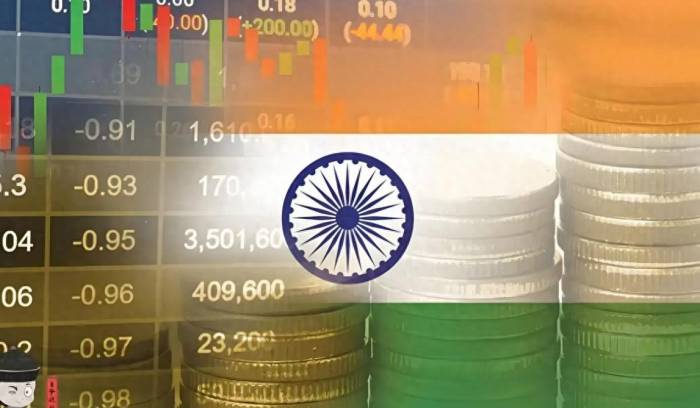The Rupee Plummets
In recent times, fluctuations in the US dollar have sent ripples throughout the global economy, with countries scrambling to safeguard their currencies. Amidst this frenzy, India found itself facing a turbulent monetary tide that saw its currency, the rupee, sliding downwards, reminiscent of a young skater losing balance. The depreciation of the rupee reached alarming levels, hitting lows not seen since 1983. The gravity of the situation was such that a significant plunge seemed imminent if action did not materialize.
However, India was not idle in the face of this crisis. The authorities swiftly intervened, tapping into their foreign exchange reserves. In an impressive move, the Reserve Bank of India (RBI) injected a staggering $50 billion into the market in efforts to stabilize the falling rupee. This maneuver was crucial for Modi’s government, as the specter of “collapse” was certainly not an outcome they wished to entertain. Despite these efforts, India's foreign reserves were reduced to $657.9 billion, raising concerns about the sustainability of such tactics.
Advertisement
But why didn't India mirror the strategies employed by heavyweight nations like China or Japan, known for their massive holdings of US Treasury bonds? One might question this, pointing out that these countries often sell off their bonds during critical moments to easily secure liquidity. India, contrastingly, chose to utilize its dollar reserves directly. This decision stems from a unique understanding of its economic landscape.
To grasp India's decisions, one must understand the economic reality it contends with. Contrary to the popular perception that India is flourishing as an emerging economic star, it grapples with a significant trade deficit. In the previous year, this deficit soared to a staggering $238.9 billion. Despite robust trade activity, the underlying truth remains: it is often more loss than gain. Thus, relying on US Treasuries to bolster the rupee would be a precarious path, considering India's foreign reserve levels are not as robust as its counterparts. Additionally, the country’s infrastructure and manufacturing sectors lag significantly behind, leaving little room for foreign trade to act as a buffer against liquidity crises.
India's economic model differs sharply from that of China, which secures surpluses via manufacturing exports. In contrast, India predominantly relies on its oil trade, purchasing crude from Russia and reselling it to other nations for profit. This middleman approach, while potentially lucrative, highlights the fragility of India's economic structure. The manufacturing domain, apart from pharmaceuticals and low-skill labor industries, lacks significant competitive output.
Engaging its foreign reserves to prop up the rupee is akin to administering a “steroid shot” — a temporary boost sourced from reserves that are not infinite. The pressing question now arises: is this method sustainable in the long run? The outlook appears grim. Persistent reliance on such tactics risks draining India’s financial arsenal. As the dollar index continues its climb, the pressure on India will only intensify, potentially leading to a precarious predicament for the nation.
Moreover, this tactic of forced stabilization does little to remedy the underlying issues within the domestic economy. India's significant infrastructural deficiencies stand as a major hindrance to ambitious manufacturing upgrades. The state of its railways, for instance, is notorious, often depicted in films with scenes of passengers clinging onto the rooftops of overcrowded trains; this is not mere exaggeration but a stark reality. Operating a thriving manufacturing sector under such conditions is nothing short of a delusion.
As for attracting foreign investment, the narrative is similarly disheartening. There was once a swell of optimism among companies aiming to replicate China's success by leveraging India's cheaper labor. However, this belief often dissipated upon encountering the reality of India’s workforce, which lacks the same drive as their Chinese counterparts. As a result, many companies, disillusioned by their experiences, have turned their attention to Vietnam as a more appealing destination for their investments.

What India faces now is characterized as treating symptoms but leaving the underlying ailments unaddressed; the challenge at hand is one that cannot be solved merely by tapping into foreign reserves. For a true recovery, India must summon the courage for transformative actions that upgrade infrastructure and enhance manufacturing capabilities rather than relying on short-term measures like sacrificing foreign reserves or engaging in "oil middleman" operations.
The trajectory of India’s economy increasingly hangs in the balance, significantly influenced by its ability to withstand the pressures posed by a rising dollar index. Should the dollar continue its ascent, India’s limited foreign reserves may not suffice, leading to heightened financing costs for domestic enterprises and increasing risks of economic recession. A descent into this vicious cycle presents challenges that simple reliance on packaging and offloading dollar reserves cannot surmount.
In light of the ongoing dollar surge, one must ponder whether India can bank on its foreign reserves to weather the storm. Will the nation find itself mirrored in cinematic tales of miraculous recovery, or face the stark reality of economic limitations? It remains to be seen how this unfolding narrative will develop, but the stakes are undoubtedly high.
Post Comment